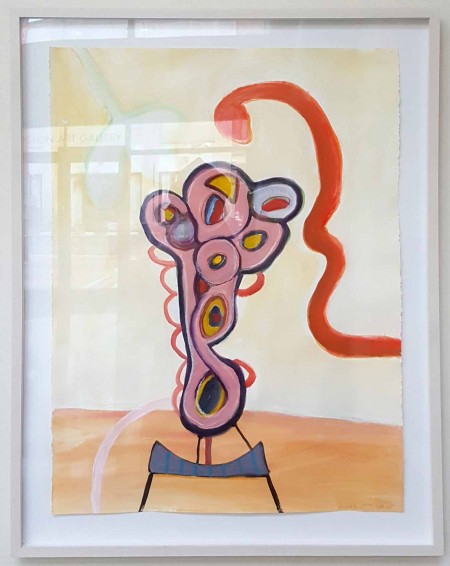The exhibition of paintings by Dennison W. Griffith at the Weston Art Gallery in the Aronoff Center reminds us of some fundamental truths about life and about art. Griffith, a prominent Ohio artist and arts administrator for almost forty years, died of cancer on January 18 at age 63. In the fall of 2013 he had retired as president of the Columbus College of Art and Design. Soon after he began the series of paintings shown in this exhibition, he was diagnosed with an inoperable form of cancer. For the next two years he continued to paint what became his final statement as an artist. It is a statement that speaks to the wonder we feel as children and the lessons we learn as adults.
If you wanted to take a child on his or her first visit to an art gallery, this would be the show to choose. There are only 15 works, some monumental, others not as tall as a 4-year-old. The composition in each is simple: a figure standing in a landscape of earth and sky. But this is where the everyday world ends and another world takes over. A youngster would probably see the figures as creatures from outer space or perhaps a cartoon character in a video game. The figures stand on stilts that can serve as both arms and legs. Their most prominent features are gaping openings, maybe an eye, maybe a mouth. However peculiar their anatomy, the creatures are unmistakably friendly. I suspect they would make a child laugh.
The colors in these paintings also break rules. The sky could be blue, but more often than not it is whatever color the artist wants it to be, perhaps pale red or murky yellow. There are funny shapes in these skies; some look like clouds, others like snakes. The best colors are reserved for the creatures. They are decked out in bright yellows and reds and blues and pinks, offset by just enough white to give the colors punch. With your young gallery goer, stand in front of 4.17.2015 (the titles are based on the dates of the paintings). The slightly madcap creature, rendered mostly in pink, is having a good time as shapes swirl around its head.
Children may not be interested in the brief video about Dennison Griffith that streams during the exhibition, but grown-ups should not miss it. Most of the works in the show are large oils done on encaustic covered gatorboard. There are a few smaller acrylics on paper. In the video we see Griffith, his clothes covered in beeswax and pigment, at work and hear him talk about these paintings. His failing health makes the video poignant, but it is ultimately an uplifting opportunity to listen to an artist talk about how and why he creates. Griffith describes his painting as an “improvisational process.” As the series grew, he discovered he had a “family of characters” that were related to each other. He acknowledges that the shapes are biomorphic, resembling cells and microorganisms, but he is emphatic: these paintings “are not about the cancer.” They are about life and humor and mystery and playfulness.
The playfulness is, in fact, decidedly adult. The cells, with their vaginal openings, are clearly involved in reproduction with the sperm swimming around them. In 7.1.1015, one of two monumental works hung in the Street-level Gallery, the embryo-shaped cell appears to be dividing and reproducing itself within a uterus. “Untitled,” a small acrylic, also hangs in the Street-level gallery. Here the biomorphic shape resembles a bouquet of flower-like cells bursting into bloom beneath a protectively hovering sperm. Facing his own mortality, Griffith tells us these final paintings are “about the joy of being alive.” Life, like art, will continue to blossom after he is gone.
As with all art, the meaning of these paintings is ultimately in the eye of the beholder. People familiar with 20th century abstract art will recognize the influence of the organic shapes used by Surrealists such as Miro, Dali, and Arp in the thirties and forties. Dennison may be associating contemporary American life with the fragmentation of Europe between the wars. I would single out two works in the exhibition that I think are exceptionally fine. 5.30.2014 is more muted in its coloration than many of the other paintings. The central figure stands on yellow-green ground against a peach colored sky. The flowing shapes are not surrounded by the bold, dark lines found in many of the paintings, giving this encaustic the appearance of fresco that has mellowed with time. As its title indicates, “First” (2013) began the series of paintings. It is a sublime composition with soft lines and muted, harmonious colors. This painting was done before Griffith received his cancer diagnosis. Unaware of what lay ahead, he went about the business of creating a beautifully mysterious work of art that serves as a moving tribute to his vision and skill as a painter.
Dennison W. Griffith: Another World runs from June 17 to August 28, 2016, at the Weston Art Gallery in the Aronoff Center.
–Daniel A. Burr






